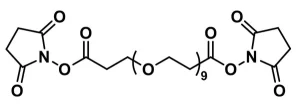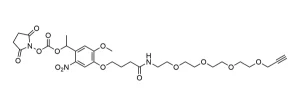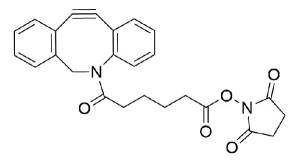Vector Laboratories is closed for the President’s Day on Monday, February 19th. We will be back in the office on Tuesday, February 20th.
We will respond to emails upon our return. Have a wonderful day.
Menu
Vector Laboratories is closed for the President’s Day on Monday, February 19th. We will be back in the office on Tuesday, February 20th.
We will respond to emails upon our return. Have a wonderful day.
Bis-dPEG®5-NHS ester, product number QBD-10224, is a homobifunctional, amine-reactive, single molecular weight PEG crosslinker with a short, discrete PEG (dPEG®) chain length. Each end of the chain terminates as the N-hydroxysuccinimidyl (NHS) ester of propionic acid. Unlike traditional hydrophobic crosslinkers, Bis-dPEG®5-NHS ester will not cause problems such as aggregation, precipitation, and inactivation when conjugated to biomolecules. Various uses for Bis-dPEG®5-NHS ester have been published in the scientific literature.
NHS esters react with free amines such as the ε-amines of lysine. The optimal pH range for NHS esters to react with free amines is 7.0 – 7.5. However, NHS esters can react with free amines with pH as low as 6.5. NHS esters are susceptible to hydrolysis in aqueous media. As the pH increases, the hydrolysis rate of the ester increases. Thus, we strongly discourage storing Bis-dPEG®5-NHS ester in water or aqueous buffer. Instead, we recommend that customers make new solutions of the product as needed, use them immediately, and discard unused solutions after use. If customers desire to store the product in solution, we recommend the use of a pure, anhydrous, water-miscible solvent such as dimethyl sulfoxide (DMSO), N,N-dimethylacetamide (DMAC), or N,N-dimethylformamide (DMF). DMSO, DMAC, or DMF can be dried chemically or by storing for a minimum of 24 hours over 3 Å molecular sieves. With DMF, use only fresh solvent as the compound decomposes over time to form free amines that will react with the NHS esters.
| Unit Size | 100 mg, 1000 mg |
|---|---|
| Molecular Weight | 532.50; single compound |
| Chemical formula | C₂₂H₃₂N₂O₁₃ |
| CAS | 756526-03-1 |
| Purity | > 97% |
| Spacers | dPEG® Spacer is 19 atoms and 21.568 Å |
| Shipping | Ambient |
| Typical solubility properties (for additional information contact Customer Support) | Methylene chloride, Acetonitrile, DMAC or DMSO. |
| Storage and handling | -20°C; Always let come to room temperature before opening; be careful to limit exposure to moisture and restore under an inert atmosphere; stock solutions can be prepared with dry solvent and kept for several days (freeze when not in use). dPEG® pegylation compounds are generally hygroscopic and should be treated as such. This will be less noticeable with liquids, but the solids will become tacky and difficult to manipulate, if care is not taken to minimize air exposure. |
Greg T. Hermanson, Bioconjugate Techniques, 3rd Edition, Elsevier, Waltham, MA 02451, 2013, ISBN 978-0-12-382239-0; See Chapter 18, Discrete PEG Reagents, pp. 787-821, for a full overview of the dPEG® products.
Cyclic and dimeric gluten peptide analogues inhibiting DQ2-mediated antigen presentation in celiac disease. Jiang Xia, Elin Bergseng, Burkhard Fleckenstein, Matthew Siegel, Chu-Young Kim, Chaitan Khosla and Ludvig M. Sollid. Bioorganic & Medicinal Chemistry. 15 (2007) pp 6565–6573. July 25, 2007. DOI: 10.1016/j.bmc.2007.07.001.
Design of a Potent D-Peptide HIV-1 Entry Inhibitor with a Strong Barrier to Resistance. Brett D. Welch, J. Nicholas Francis, Joseph S. Redman, Suparna Paul, Matthew T. Weinstock, Jacqueline D. Reeves, Yolanda S. Lie, Frank G. Whitby, Debra M. Eckert, Christopher P. Hill, Michael J. Root, and Michael S. Kay. Journal of Virology. 2010, 84 (21) pp 11235–11244. November 2010. DOI: 10.1128/JVI.01339-10.
Ligand-regulated oligomerization of b2-adrenoceptors in a model lipid bilayer. Juan Jose´ Fung, Xavier Deupi, Leonardo Pardo, Xiao Jie Yao, Gisselle A Velez-Ruiz, Brian T DeVree, Roger K Sunahara and Brian K Kobilka. The EMBO Journal, 2009, 28, pp 3315–3328. September 17, 2009. DOI: 10.1038/emboj.2009.267.
Monitoring the switching of single BSA-ATTO 488 molecules covalently end-attached to a pH responsive PAA brush. Namik Akkilic, Robert Molenaar, Mireille M.A.E. Claessens, Christian Blum, and Wiebe M. de Vos. Langmuir. 2016, pp 1-10. August 15, 2016. DOI: 10.1021/acs.langmuir.6b01064.
G-Quadruplex Induction by the Hairpin Pyrrole–Imidazole Polyamide Dimer. Shunsuke Obata, Sefan Asamitsu, Kaori Hashiya, Toshikazu Bando, and Hiroshi Sugiyama. Biochemistry. 2018, 57, pp 498-502. December 13, 2017. DOI: 10.1021/acs.biochem.7b01059.
Surface Modification on Acoustic Wave Biosensors for Enhanced Specificity. Onursal Onen, Asad A. Ahmad, Rasim Guldiken and Nathan D. Gallant. Sensors. 2012, 12 pp 12317-12328. September 10, 2012. DOI: 10.3390/s120912317.
Surface Functionalization and Analysis Thereof for an Ovarian Cancer Diagnostic Biosensor. Asad Ali Ahmad. USF Scholor Commons. 2011, 1 (1) pp 297 416. June 21, 2011. DOI: scholarcommons.usf.edu/etd/2977.
Serum albumin ‘camouflage’ of plant virus based nanoparticles prevents their antibody recognition and enhances pharmacokinetics. Andrzej S. Pitek, Slater A. Jameson, Frank A. Veliz, Sourabh Shukla, and Nicole F. Steinmetz. Biomaterials. 2016, 89 pp 89-97, February 23, 2016. DOI: 10.1016/j.biomaterials.2016.02.032.
Interdomain regulation of the ATPase activity of the ABC transporter hemolysin B from E. coli. Sven Reimann, Gereon Poschmann, Kerstin Kanonenbera, Kai Stuhler, Sander H.J. Smits, and Lutz Schmitt. Biochemical Journal. 2016, June 8, 2016. DOI: 10.1042/BCJ20160154.
Redox-Responsive Self-Assembly of Amphiphilic Multiblock Rod–Coil Polymers. Taek-Gyoung Kim, Chingu Kim, and Ji-Woong Park. Macromolecules. 2017, 50 (20) pp 8185–8191. 10/4/2017. DOI: 10.1021/acs.macromol.7b01650.
Toward the Development of GE11-Based Radioligands for Imaging of Epidermal Growth Factor Receptor-Positive Tumors. Benedikt Judmann, Diana Braun, Ralf Schirrmacher, Björn Wängler, Gert Fricker, and Carmen Wängler. ACS Omega 2022, 7, 31, 27690–27702. 2022. https://doi.org/10.1021/acsomega.2c03407
Multivalent Benzamidine Molecules for Plasmin Inhibition: Effect of Valency and Linker Length. Tanmaye Nallan Chakravarthula, Dr. Ziqian Zeng, Prof. Nathan J. Alves. ChemMedChem, Volume 17, Issue 22, (2022), 09/16/2022, https://doi.org/10.1002/cmdc.202200364.
Applicable patents and legal notices are available at legal notices.




Stay in the Loop. Join Our Online Community
Together we breakthroughTM

©Vector Laboratories, Inc. 2024 All Rights Reserved.
How do I Request a Quote?
To request a quote for products: